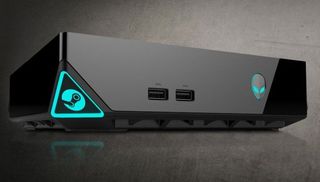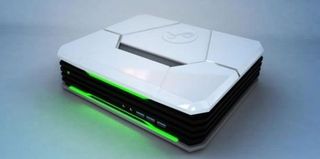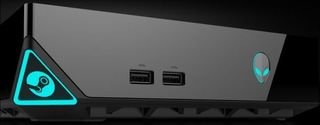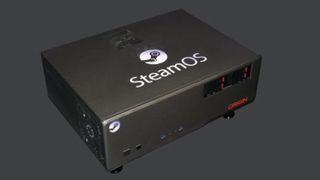Steam Machines are expensive, ugly, but full of potential

The Steam Machines are upon us . It was always clear that Valve were working with other companies to bring gaming PCs to the living room. We expected four or five, but 13 ? A new market has sprung up overnight, which means plenty of competition to judge. These small, weird and occasionally ugly new devices represent an exciting future for the platform, not because of the technology, but because of the new audiences it could usher into the unifying embrace of PC gaming. Let's take a look at the Steam Machines we have so far. Which ones are good value for money? Which ones look the best? What will they do for PC gaming?
There have been mixed reactions to the Steam Machine announcements from some "Why do I want this, I'll just build my own PC?" is one. Quite reasonable, for system builders the Steam Machine phenomenon may seem pointless, but don't underestimate the importance of accessibility. These PCs aren't designed to replace custom built desktop monsters, they're for people who don't have the time or inclination to plunge into the convoluted world of competing components with alphabetti-spaghetti naming conventions.
You'll have to pay a premium for that privilege if you go with most of the 12 options revealed at CES, however. Take the Falcon Northwest Tiki, a traditional upright tower that'll retail for between $1800 and - make sure you're sitting down - $6000 . Digital Storm's Bolt II may contain a GTX 780 Ti and a core i7, but is way too much at $2,584. At that price, you're into the enthusiast market, and those knowledgeable customers know they can build a better machine for a lot less. The huge Gigabyte box, meanwhile, runs on integrated Intel graphics tech - a dubious basis for a powerful gaming PC.

Cyberpower's effort is much more appealing. It looks like a cheap alarm clock, but at $500 it's going head to head with the Xbox One and the Playstation 4, and certainly has the power to run current games at a good clip. Buying separately, the GTX 760 inside is worth half the price of the box, and nicked a score of 90% and an editor's choice award in our review . It skimps in the right places, too. For a front-room box that'll only be used for gaming, a 500GB HDD should easily suffice, and 8GB of RAM will do just fine until the games designed exclusively with "next-gen" hardware in mind start coming out a year or so from now.
The iBUYPOWER machine is another interesting budget contender, and has the dubious benefit of looking like a Transformer's packed lunch. It's camping the $500 mark as the Cyberpower machine, but its quad core CPU loses out to the Cyberpower i5. Cyberpower is also a good company to go with if you're interested in upgrading your machine incrementally, which will be an important discerning point in the battle of the Steam machines. All of these machines are built from commercial components, which means we'll be able to switch in new graphics cards and hard drives at will. The cramped cases and differing layouts may make some harder to upgrade than others. We won't know until we get our hands inside them.
Cooling is another important issue with these small machines. The pricey Falcon and Digital Storm boxes boast conventional upright structures and big fans - a classic solution. It'll be interesting to see how smaller boxes like the boxy Gigabyte Brix Pro and the ugly Origin PC will move air effectively across their components, especially considering the twin Titans humming away inside the Origin, slurping up electricity, inflating your power bill and creating enough heat to gently boil an egg.

Alienware, meanwhile, claim they've solved the cooling problem with an airflow that sucks cool air from below and vents it out of the rear. It's designed to be slotted into a stack between Blu Ray players and the like, but for the love of Gabe, don't put it on top of the top-vented Xbox One, or you'll have two machines sucking on the same air stream - not the kind of cross-platform competition you want.
The biggest gaming news, reviews and hardware deals
Keep up to date with the most important stories and the best deals, as picked by the PC Gamer team.
The Alienware device is the most mysterious and interesting entry of the bunch. It takes prize position in Valve's Steam Machine catalogue , but lacks precise specifications or a price (though according to their Steam Machine page , it'll run on an Intel CPU and an Nvidia GPU, and compete with next-gen console pricing). It's the culmination of a period of collaboration with Valve, and according to The Verge , Valve's Greg Coomer has said it's the machine "we think is actually going to serve the most customers and make the most Steam users happy."
Alienware typically fuse garish neon lights with stealth bomber shapes to imposing effect, sometimes going a little too far in pursuit of their chunky brand of futurism. Their Steam Machine, however, is reserved, stylish and tiny. At three inches tall and eight inches long, it's a gaming PC the size of a cook book, and much smaller than the Xbone and the PS4. Alienware claim it'll deliver 1080p performance at good framerates. It's due out late this year.
It's easy to be suspicious at the claims of affordability, given Alienware's tendency to target high-end enthusiasts. Also bear in mind the fact that Alienware basically already have a Steam Machine in the form of their small-form-factor, customisable X51 machines, which start at $700. The only difference is that the X51 comes with Windows installed by default. All of these machines are essentially mini PCs, all of them can run on an OS of your choosing with some fiddling, though that does undermine the plug-in-and-play appeal.

Which brings us to the other limitation of the Steam Machine concept: the OS. SteamOS' Linux roots mean it'll ultimately be more customisable than Windows, but the library of Linux compatible games is still comparatively very slim. Check out Craig's account of living with Linux for a sense of the difference the Windows to Linux switch can make. More and more studios are porting to Linux, particularly after Valve's SteamOS announcement, so we may see growing parity if Steam Machines gain traction.
When will that happen? Many of these machines don't have final specifications locked down, and four of them don't have price estimates. None of them, bar Alienware's vague estimate, have a release date. They're a bit of a mixed, motley bunch, but there's clearly much more to come from these machines. Our people at CES are taking a closer look at each, and we'll have more detailed impressions in the coming days.
Of course, some of us have no need for another high-end PC. I'm even more interested in Valve's new streaming tech, which they've yet to expand upon beyond the announcement of their November beta . The idea of a dongle that'll stream high quality, responsive footage from my PC is pretty desirable, especially if it has the power to stream movies and music from the internet and serve as a tiny multimedia lounge hub. PC gaming is assuming many new shapes and sizes in 2014, which is a rather exciting thing.
Part of the UK team, Tom was with PC Gamer at the very beginning of the website's launch—first as a news writer, and then as online editor until his departure in 2020. His specialties are strategy games, action RPGs, hack ‘n slash games, digital card games… basically anything that he can fit on a hard drive. His final boss form is Deckard Cain.
Most Popular


